How Denmark became a global leader in digital government

Denmark sits atop almost every report and survey on public sector digitalization. It has the highest usage of digital services in the EU and some of the highest levels of citizen satisfaction with public services in the world. The Danish Government’s journey exemplifies how public sector digital transformation can succeed. Discover how Denmark became a digital-first nation, and how its digitalization strategy is paying dividends.
When you’re looking at government digital transformation success stories, there are few countries that beat Denmark.
Just some of the many notable recognitions of Denmark’s excellent performance in digital transformation include:
- #1 in the U.N.’s bi-annual e-Government Survey, 2018-2024.
- #1 in the EU’s Digital Economy and Society Index, 2017, 2018, 2021.
- #1 in Economist Impact's Digital Cities Index, 2022 (for Copenhagen).
- #2 in the OECD’s Digital Government Index, 2023.
- The highest number of citizens using e-government services across the EU, with 93% of Danish internet users using digital public services in 2021.
Some may claim Denmark’s small population and higher-than-average taxes make it easier for the Danish Government to excel in digitalization. While this is a factor, Denmark’s egovernment digitalization journey started decades ago, and as you’ll see, involved many carefully considered stages.
In this article you'll discover how Denmark became one of the world’s most digitalized countries. The tools they implemented, the legislation they used to encourage adoption, and how much money they’ve saved and citizen trust and satisfaction they’ve built.
Table of contents
Denmark has had clear and careful digitalization goals in place for over 20 years. In their Digital Denmark: Conversion to the network society report (1999), the Ministry of Research and Information Technology outlined many objectives that established the path the Danish Public Sector would walk over the next two decades. These included:
- Life-long learning: “Denmark [should] be the first country in the world, to ensure its citizens access to life-long learning via the network society.”
- Digital administration: “at the latest by 2003, Danish public administration is to provide the best and most efficient public service in the Nordic countries with the help of digital administration.”
- Danish internet initiatives: “participation in democracy, open decision-making processes and Danish cultural activities to be supported by new and interactive Internet services for all citizens by 2003 at the latest.”
These goals set the foundation that facilitated Denmark’s rise to becoming a world leader in digital government.
First, by educating citizens about digitalization, they ensured digital technology could be used by the public with less friction.
Second, by committing to digital administration, they set out update legacy systems and create efficient and effective digital public services for citizens and government employees.
And third, by incorporating the internet into their democracy and cultural activities, they made not just top-down political changes, but citizen-centered cultural changes.
Today, Denmark’s Agency for Digital Government continues to update its digital strategy with new reports every four years. It regularly engages in public-private partnerships to boost its digital capabilities. And it consistently improves services with a focus on inclusion and engagement for citizen centricity.
Discover the 6 strategies egovernment leaders use to deliver a better citizen experience

MitID, which translates to “my ID”, is the e-identification service that’s key to a digital Denmark. It enables Danish residents and businesses to identify themselves electronically for all digital services, both public and private, as well as sign documents and log in to digital banking, health services, taxes, and much more.
Denmark carried out the first pilot project for digital signatures in 1999. 11 years later, NemID was introduced. This was a form of two-factor authentication in which residents used a key card to verify their identity.
In 2022, Denmark rolled out the third generation of Danish eID, MitID. Developed in a public-private partnership with Danish banks, MitID was designed to improve usability and meet rising concerns of cyber-fraud and phishing with enhanced security.
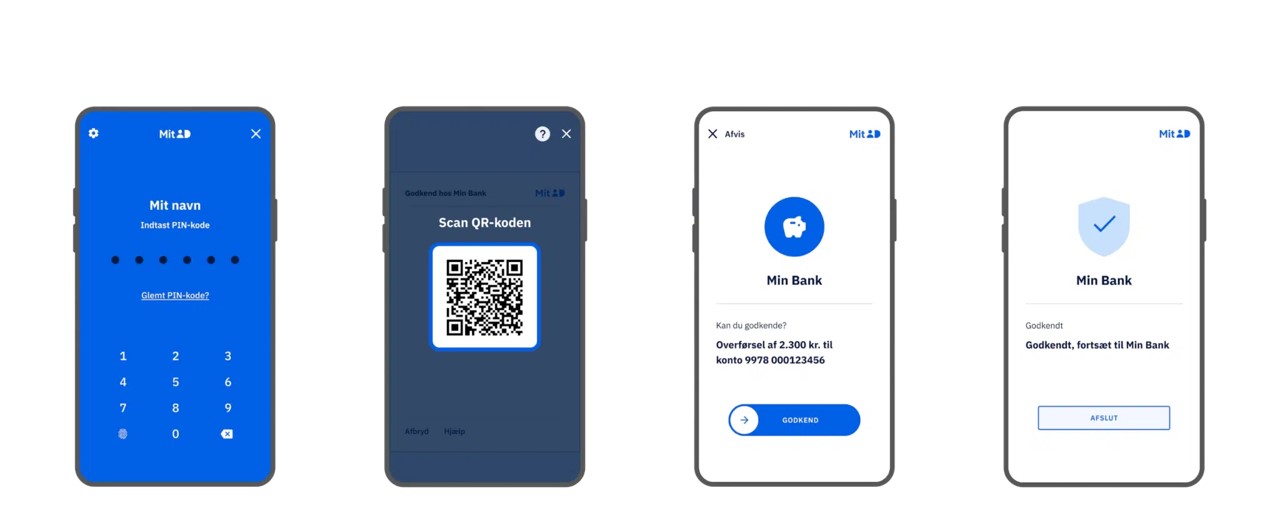
Relative to Denmark's population, MitID is one of the most successful egovernment identification tools in the world:
- 96.6% of the Danish population over the age of 15 have an active MitID
- Denmark's 5.5 million MitID users make a combined 89 million monthly transactions using MitID
- 83% of users are satisfied with MitID
- 87% report using MitID at least once a week
- 89% of users feel secure using MitID
Rikke Hougaard Zeberg, Director of the Agency for Digitisation, explains, ”It is the secure key to the digital Denmark, and what is amazing about it is that it works across the public and private sector.”
NemLog-in is the common login page for public services that uses MitID. It's a nation-wide version of Single-Sign-on (SSO) that reduces friction and creates consistency across the internet for people and businesses.
All public services have a log-in page Danish residents are familiar with, and they need only remember one identity number and log-in code to access almost everything.
RELATED: Digital Public Services: 4 Steps to Citizen-Centric Service Delivery
Digital mailboxes are nothing new (after all, your email is a digital mailbox), but Denmark’s Digital Post platform equips government agencies and authorities to communicate with citizens and businesses securely and reliably.
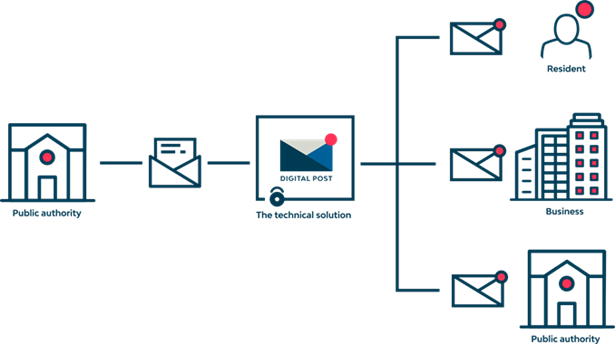
One key feature of Digital Post is that legislation makes it obligatory for people and businesses to read it, meaning messages sent through Digital Post have legal effect.
Today, citizens have a few different options for how they receive their secure digital mail. Digital Post is the name of the government’s service, which allows public authorities to send messages to citizens. E-Boks and mit.dk are supplemental services created in public-private partnerships. They’re digital mailboxes that let public sector institutions and private sector businesses securely communicate online with citizens, employees, partners, and customers.
Similar to MitID, Digital Post has extremely high usage rates:
- Digital Post is used by 94% of the Danish population
- 92% feel safe in communicating with authorities through the platform
- 83% of citizens are either very satisfied or satisfied with Digital Post
- 64% of businesses are either very satisfied or satisfied with Digital Post
Every month, millions of messages are sent via Digital Post. These messages are sent from public authorities to other public authorities, to businesses, and to residents. And, As with all Danish public services, residents use their MitID to access their Digital Post.
RELATED: Deliver Fair & Reliable Access to Digital Public Services, No Matter the Demand
NemKonto (meaning “easy account”) is a regular bank account that all Danish citizens over the age of 18 and businesses are required to have registered with the government.
It sounds quite basic, but what NemKonto enables is very significant. It means when the government needs to pay out benefits for unemployment, support for studies, or tax returns, they already know every business and citizens’ account details.
The NemKonto is linked to personal identity numbers, meaning individual authorities don’t need to know bank details, and when a person or business updates their NemKonto, it’s automatically synchronized across the public sector.
Getting a NemKonto is relatively frictionless for citizens, as when you open a bank account in Denmark it automatically becomes your NemKonto.
Need to claim unemployment? Order a new health card? Get married? Register a change of address? Pay your taxes? Report a stolen bike?
Whatever public service you need in Denmark, you can start your journey at borger.dk. “Borger” translates to “citizen”, and the site guides Danes through their interactions with government during key life events.
It's a one-stop-shop for Danish public services. What’s more, just about every single one of the many services below can be completed digitally.
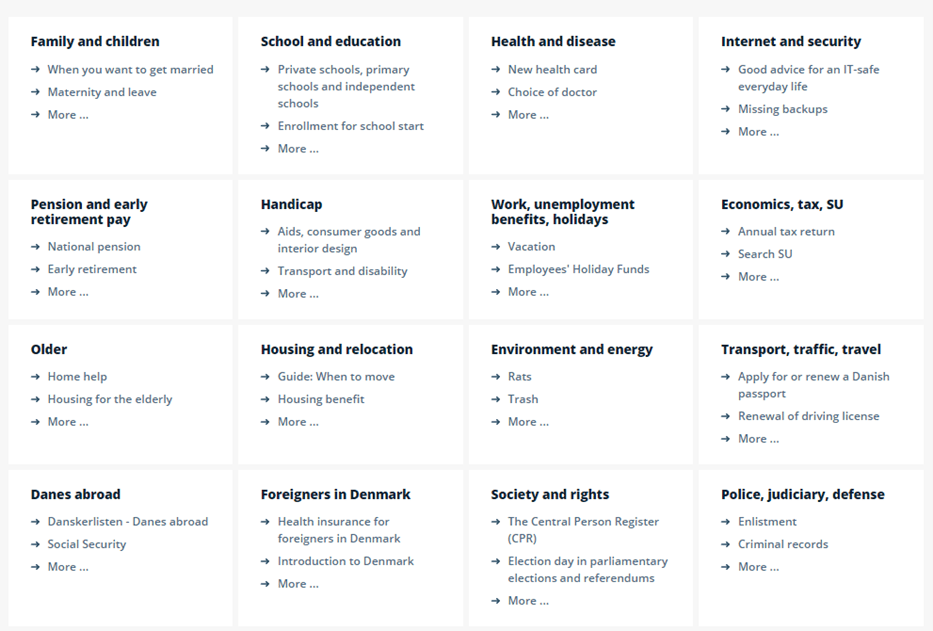
In 2024, borger.dk had over 111 million visitors, with 92% of users saying they are either very satisfied or satisfied with the service.
You can probably see how these digital services start to stack up and work together.
A Danish citizen might receive a notification that it’s tax time on her Digital Post. She’d then go to borger.dk and follow the link to the tax site. She’d log in to the tax site with MitID and NemLog-in, fill the application, then have her tax return deposited into her NemKonto.
To help their large expat community, Denmark has even built a version of borger.dk that’s in English and delivers services for international arrivals.
Like many private sector companies, Denmark's Government doesn't settle for digital services that just work. Instead, they optimize to improve usability and the customer experience.
This focus on the customer/citizen experience is key to the high usage of digital services among Danish citizens, and is perhaps most evident in the development of mobile apps that accompany the listed services above and more.
They have a Danish Driving License App, which works exactly as a physical driver’s license. It includes features like notifications when a license needs to be reviewed and dynamic QR codes that can be used by both authorities and residents to verify identity.
There’s an app for their Danish Health Insurance Card, which gives citizens the right to receive healthcare in Denmark. There are apps for accessing your Digital Post, using your MitID, and sending money between parties with just a phone number.
Some key stats on the app-ification of Denmark's egovernment include:
- The health insurance card app has been downloaded 2.9 million times since its launch in 2021
- It is used 52,000 times every day
- The driving license app has been downloaded 2.7 million times since its launch in 2020
- It is used 51,000 times every day
RELATED: Public Sector Digital Transformation and the Citizen Experience
Denmark’s digital government services deliver a superior citizen experience by meeting the four core tenets of user needs: they’re functional, reliable, usable, and pleasurable.
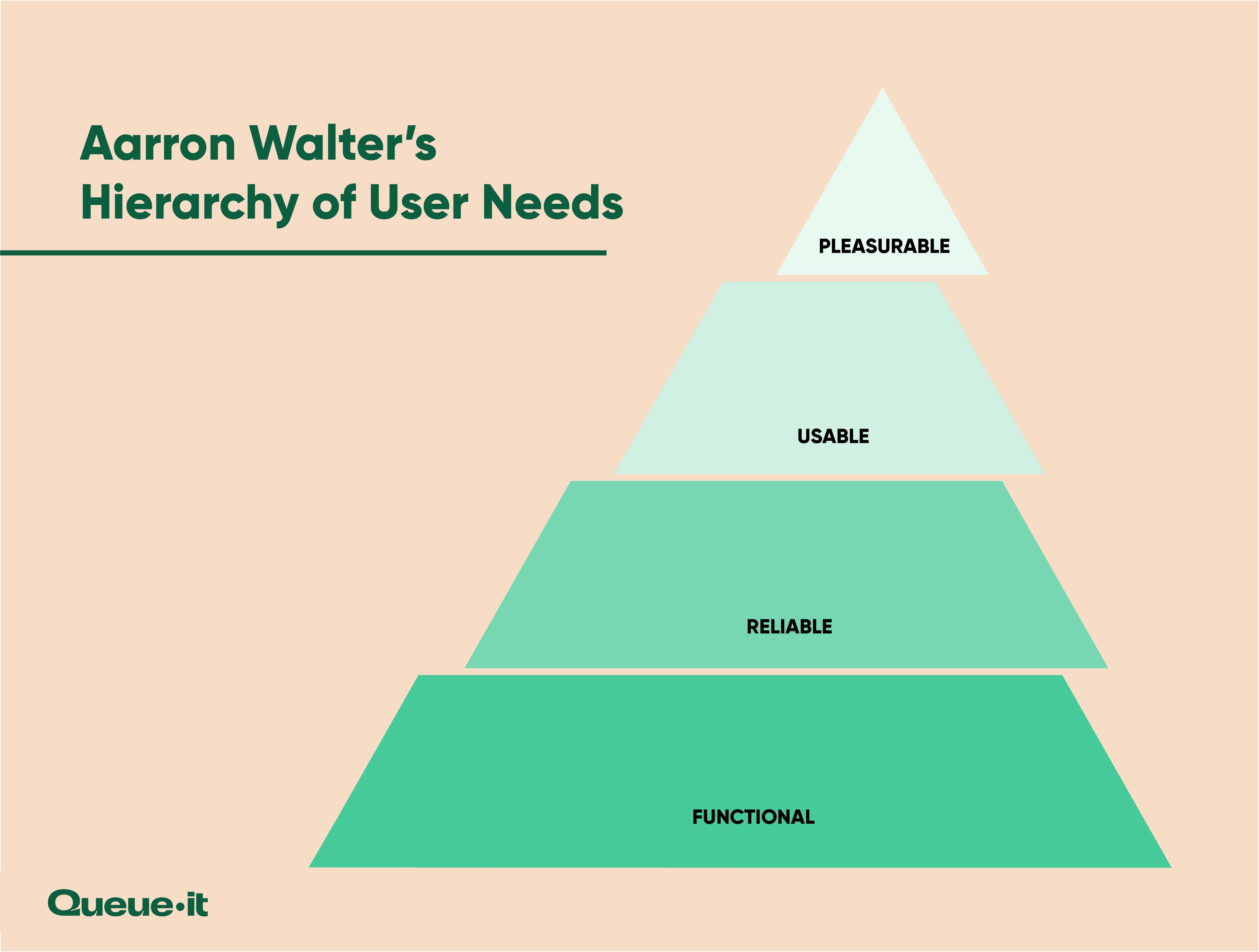
You can see the alignment with these core user needs displayed in many of the services and strategies we’ve listed above:
- Functional: Digital services that not only function, but function together in an integrated way.
- Reliable: Services that are available 24/7 and protected against high demand.
- Usable: One log-in to remember across government, a consistent user experience across services, a simple and effective way to communicate with government, a website that guides every citizen to the services they need.
- Pleasurable: Frictionless services with many functions occurring automatically and being synchronized across government, apps that enhance the user experience.
For example, to ensure reliability, Denmark's public services like taxes and health services are protected by a virtual waiting room. This safeguards these services against website crashes and performance issues caused by high demand, meaning sites are online 24/7 and citizens know they can count on them to perform when they need it most.
RELATED: Prevent Government Website Crashes by Controlling Traffic
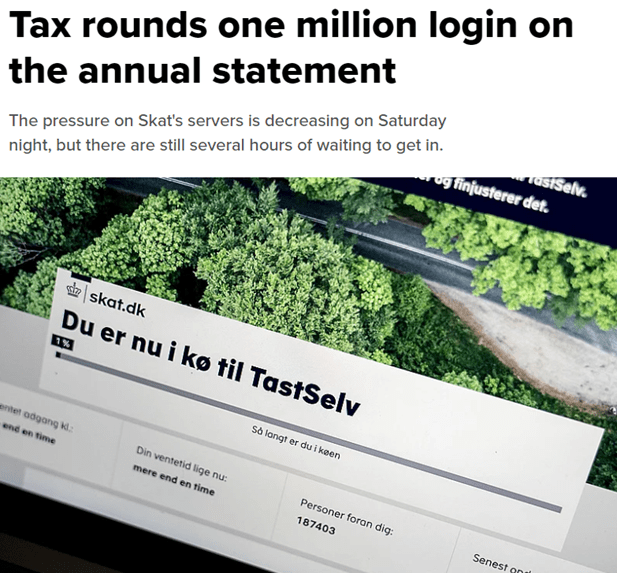
While the tax sites like the IRS crash across the world at tax time, Denmark’s skat.dk (“skat” means “tax”) consistently remains online. When it faces high demand, citizens are placed in a virtual waiting room before they’re throttled to the website in a first-come first-served order.
Discover 6 research-backed steps to citizen-centric service delivery

We’ve established the “what” of Danish digitalization, but when you’re trying to transform something or inspire change among government leaders, the “why” is often the most important thing.
So now, let’s look to why Denmark has been investing big in digitalization for the past 20+ years, and how it’s paid off.
The time and resource saving benefits of digitalization are often touted in reports and surveys, but Denmark’s digitalization offers a real-world example of just how profound the benefits can be.
Government data shows Denmark’s digitalization effectively saves 296 million EUR ($317.7 million USD) annually and has reduced processing time by 30% across departments.
Denmark's most recent digital strategy aims to free up the equivalent of 10,000 full-time jobs over the next 10 years through automation and digital self-service.
Reports indicate citizens who are satisfied with public services are nine times more likely to trust their government than those who are not.
Is this the case for Denmark?
Well, in Denmark, 91% of citizens who accessed an authority’s website or used self-service solutions were satisfied. The European Commission rated Denmark’s digital public services a score of 87.1, 19 points above the EU average of 68.1.
Across the four major areas of public service delivery, Denmark (displayed below in orange) outperforms OECD averages (displayed in green).
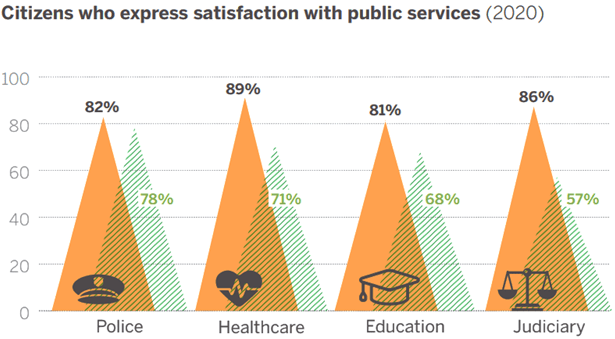
While there’s no way to trace a direct link, the Danish government has some of the highest levels of citizen trust in the world. 72% of Danish citizens express trust in their government, compared to the OECD average of just 51%.
Additionally, 81% of Danes trust the Danish authorities to handle their personal information carefully.
This trust has a cyclical effect. The trust Danes have in government means they’re more likely to embrace government initiatives. This makes government initiatives more likely to succeed. When these initiatives succeed, Danes are more likely to feel that their government works for them. And this circles back to building more trust.
Creating trust in government is always important, but as we’ll get into, it becomes essential during times of crisis.
Denmark’s Government's advanced digitalization meant when COVID-19 hit, they were well prepared.
Not only were all their public services already accessible online, but their eID system helped them become one of the first countries in the world to introduce COVID-19 passports.
The existing eID infrastructure allowed these COVID passports to be created more easily in a secure way citizens were already familiar with. In just 11 months, citizens accessed COVID-19 passports and test results 100 million times.
Throughout the uncertainty of the pandemic, the Danish Government used Digital Post to communicate updated rules and restrictions and inform citizens about stimulus benefits, vaccines, and public health strategies.
When the government distributed stimulus benefits, they already had everyone in the country’s NemKonto, a ready-to-go bank account for them to deposit funds into. In Autumn 2020, this enabled the automatic payment of government stimulus checks to two million inhabitants in less than 8 days.
With a massive 90% of Danes reporting trust in the Danish health authorities, citizens were more prepared to follow health advice. At the height of the pandemic, more than 60% of Denmark’s adults were getting weekly COVID-19 tests.
And finally, when vaccination registrations were announced, the Danish government avoided the website crashes and issues faced across the U.S., Asia, and Europe. Instead, they had a virtual waiting room in place that ensured their registration website remained online and citizens received fair and equal access to the essential service.
The many high rankings Denmark receives in reports on government digitalization are no accident. For over two decades, Denmark has set clear and careful digitalization goals and followed through on them.
They’ve funded digital innovation, encouraged uptake of digital services with legislation, educated citizens, and engaged in public-private partnerships to create a broad range of effective and integrated digital public services.
With NemID, Digital Post, NemKonto, borger.dk and more, Denmark has fulfilled its vision of becoming a data driven, “digital first” nation. These efforts were most recently recognized in the 2024 when the UN ranked Denmark the world's top government for digitalization.
Its story serves as an important real-world case study on how digital transformation in government can succeed. It shows digitalization and citizen-centric service delivery save governments’ money and time while building trust and satisfaction among citizens.
(This blog has been updated since it was originally written in 2022).